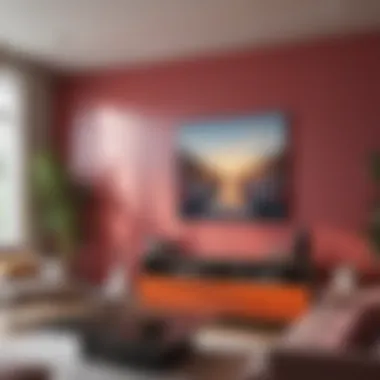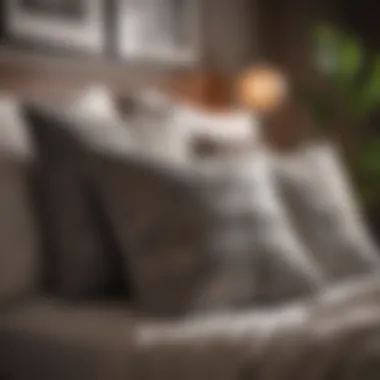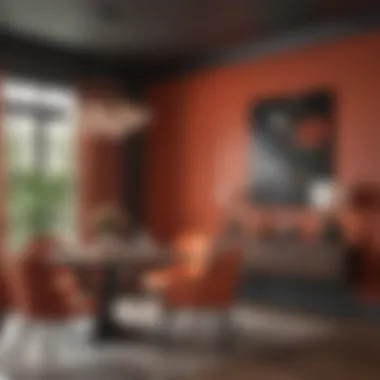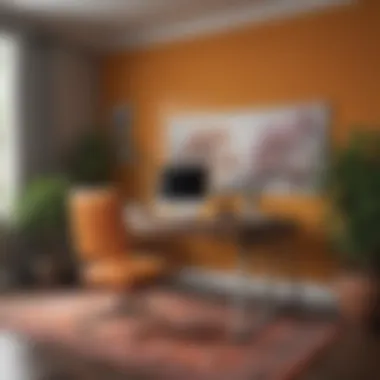Accent Room Colors: Transforming Spaces Intentionally


Intro
Accent room colors serve as a significant component in interior design, shaping not only aesthetics but also influencing how spaces are perceived. This article aims to explore the multifaceted role of accent colors, examining their psychological effects and practical applications. By understanding how color affects mood and perception, homeowners can make more informed decisions when choosing hues that reflect personal style while enhancing their environments.
Color has a profound impact on the human mind and can evoke different emotions and responses. For instance, cool colors like blue and green often promote tranquility, while warmer tones such as red and orange can stimulate energy and excitement. Recognizing these nuances is essential when selecting accent colors, as they can transform a simple room into a unique expression of personality and comfort.
In discussing accent colors, we will delve into current design inspirations and offer practical tips that homeowners can implement. This depth ensures that readers are not only aware of the theories behind color application but also equipped with actionable strategies to realize their design visions.
Color isn’t just a nice-to-have; it’s a powerful tool that can shift perceptions and enhance spaces.
Through this exploration, we aim to provide insights for homeowners, interior design enthusiasts, party hosts, and gardening aficionados. The objective is to foster a thoughtful approach to color selection that promotes harmony and enhances visual appeal. Let's begin our journey by examining design inspiration.
Understanding Accent Colors
Accent colors play a critical role in interior design. These colors are not just aesthetic additions; they serve to enhance the visual impact of a space. Understanding accent colors is essential for creating a cohesive and intentional design. Properly chosen accent colors can bring energy, focus, or calmness to a room, depending on your goals.
When discussing the significance of accent colors, it is essential to recognize their ability to influence mood and perception. For instance, a room adorned with warm accent colors such as red or orange can promote warmth and coziness. Conversely, cool colors like blue or green may create a tranquil atmosphere. This understanding can guide homeowners in making thoughtful choices that reflect their personal style and desired ambiance in their living spaces.
Definition and Importance
Accent colors refer to hues that are used sparingly within a room to draw attention or provide contrast. They stand out against the primary color palette, highlighting key elements in the design. Utilizing accent colors effectively can define spaces, emphasize architectural features, and even influence how light interacts within a room. This layer of complexity adds depth to interior spaces, transforming the overall aesthetic.
The importance of understanding accent colors also lies in their capacity to create focal points. For example, an accent wall painted in a vibrant shade can serve as a centerpiece, redirecting attention from less engaging areas. This strategic use of color not only enhances beauty but also makes a statement about the occupants' taste and personality.
Color Psychology in Interior Design
Color psychology is an essential aspect of understanding accent colors. Different colors evoke varied emotional responses. For instance, yellow can elicit feelings of happiness and positivity, while gray may convey sophistication and neutrality. When selecting accent colors, it is crucial to consider how these colors will affect the mood and atmosphere of each room.
A thoughtful approach to color psychology enables homeowners to curate spaces that not only look appealing but also feel desirable. For example, if a living room is intended for relaxation, softer shades like pastel blues or greens might be appropriate as accent colors. In contrast, a home office may benefit from dynamic accent colors that inspire creativity and focus, such as a deep red or bright orange.
In summary, understanding accent colors equips homeowners and design enthusiasts to make informed decisions. By carefully blending practical applications with the emotional significance of colors, individuals can create spaces that resonate on multiple levels, achieving both aesthetic value and functional purpose.
Choosing the Right Accent Colors
Choosing the right accent colors is essential for establishing the desired mood and atmosphere in any living space. Accent colors can uplift, relax, or energize a room depending on how they are applied. Knowing what to consider when selecting these colors can steer homeowners and designers toward more intentional and effective choices. Moreover, understanding the context in which colors are used helps in maintaining a cohesive look throughout the home.
Factors to Consider
Room Function
Each room has a specific purpose, which should influence its color scheme. Consider how the function of a room shapes its ambiance. For example, a home office promotes productivity, requiring colors that inspire focus, such as shades of blue or green. Alternatively, a bedroom is a personal sanctuary meant for relaxation. Here, soft tones like lavender or light gray might be preferable. The key characteristic of room function lies in how it directs the emotional response of its occupants. Choosing the right accent color related to the room’s purpose can significantly enhance its usability and comfort.


Lighting Conditions
Lighting conditions play a crucial role in how colors appear within a space. Natural light can brighten colors, making them look more vibrant, while artificial light may alter their appearance dramatically. For instance, warm bulbs might enhance golden hues but dull cool colors. It’s important to analyze the light sources in a room before finalizing color choices. This factor is essential, as the unique feature of lighting conditions can either harmonize or clash with the selected accent colors, potentially affecting the room’s overall feel and aesthetics.
Existing Color Palette
Identifying the existing color palette is fundamental for successful accent color selection. The interplay between new accent colors and current walls, furniture, and décor creates a cohesive look. An effective strategy might include choosing colors that are either complementary or provide a contrast that unifies the space. The key characteristic of the existing palette is to ensure harmony so that new additions do not disrupt the current flow. Misjudging this aspect can lead to visual clutter and disarray in the design.
Trends in Accent Colors
Staying updated with accent color trends can provide designers with fresh ideas. Colors like terracotta, seafoam green, and muted earth tones have gained popularity for their warmth and versatility. Understanding these trends helps in making choices that are both contemporary and timeless
Color Theory Fundamentals
Complementary Colors
Complementary colors are situated opposite each other on the color wheel, such as blue and orange. Their unique feature creates a striking contrast that draws attention. This can be beneficial in making certain elements stand out. However, overusing complementary colors can lead to a chaotic environment.
Analogous Colors
Analogous colors are next to each other on the color wheel, like blue, teal, and green. The harmony they create is pleasing and can seamlessly tie different elements of a room together. They offer a calm and cohesive feel but might lack the bold character that comes from complementary schemes.
Monochromatic Schemes
Monochromatic color schemes use variations of a single hue. This approach is beneficial for creating a sophisticated look. Using shades and tints of one color provides depth without overwhelming the viewer. However, it can risk appearing bland if not mixed with diverse textures and materials.
In summary, understanding the strategies for selecting accent colors allows for a thoughtful and impactful design. Choosing colors according to room function, lighting, and existing palettes ensures a visually compelling environment. Additionally, staying informed about trends and color theory assists in making educated choices that elevate any space.
Applications of Accent Colors
Accent colors play a crucial role in interior design. They can elevate a space, add interest, and shape how individuals perceive the environment. In each room, the choice and application of these colors create atmosphere and impact functionality. By understanding where and how to use accent colors, homeowners can make their living spaces both visually appealing and purposeful.
Living Rooms
Accent Walls
Accent walls are a popular method to introduce a bold color into a living room. They provide a focal point, breaking the monotony often associated with neutral palettes. An accent wall can highlight architectural features or artwork, making it a smart choice for those looking to create visual intrigue. The key characteristic of accent walls is their ability to draw attention without overwhelming the space. For instance, using a deep navy blue behind a light-colored sofa creates contrast, adding depth to the room. However, it is vital to choose a color that harmonizes with existing elements; otherwise, it may clash, detracting from the overall design.
Furniture and écor Choices
Selecting the right furniture and décor is another way to incorporate accent colors in living rooms. This involves choosing cushions, rugs, or even a bold piece of furniture that aligns with your vision. The key aspect here is flexibility; these items can be easily changed to refresh the entire room’s vibe. For example, bright yellow cushions can enliven a neutral couch, creating a cheerful and inviting atmosphere. However, too many contrasting colors can cause clutter, making it important to maintain some balance and cohesion throughout the space.


Bedrooms
Bedding and Accessories
Bedding serves as a significant accent point in bedrooms. Choosing a duvet cover in a striking color can set the tone for the entire room. The key characteristic of bedding choices is their comfort, combined with aesthetic appeal. By incorporating patterned throws or colorful pillows, one can enhance the ambiance without sacrificing coziness. Accessories, like wall art and decorative objects, woven into this color scheme can elevate the calming nature of the space. It is vital to avoid excessively bold patterns that might overwhelm the senses—creating serene, coordinated scenes is often more beneficial.
Paint Colors and Their Impact
The paint color on walls dramatically affects how a room feels. Lighter tones can create a sense of openness, while darker hues may cocoon the room. The unique feature of paint colors is their permanence; color choices should resonate with the intended mood of the bedroom. Soft pastels may be optimal for relaxation, while vibrant shades may energize the space. However, repainting is a considerable investment, making it essential to visualize the long-term effects before making decisions.
Kitchens and Dining Areas
Cabinetry and Fixtures
Cabinetry serves as a focal point within kitchens and dining areas. Choosing colored cabinets can either complement or contrast with wall tones, enhancing the overall design. The key characteristic of cabinetry color is its ability to define the kitchen's personality. A bold red might add excitement, while soft gray could induce calmness. While many homeowners choose white for timelessness, colored options can infuse modernity and flair to the design. However, functionality must remain a priority; darker colors could show stains more readily than lighter colors, possibly necessitating more frequent cleaning.
Table Settings and Decor
The placement of colors in table settings can transform dining experiences. Centerpieces or tablecloths in accent colors can bring energy to dining areas. The unique feature of table settings is their simplicity but profound effect. A vibrant table runner combined with neutral dishware can make meals feel special and inviting. However, using too many competing colors may create chaos, leading to a less enjoyable dining atmosphere.
Home Offices
Wall Colors for Focus
Wall colors in a home office can significantly influence productivity. Colors such as blue and green promote feelings of calm and focus, enhancing concentration. The key characteristic of these colors is their psychological effects. A well-chosen hue can foster a productive environment. While bold colors may inspire creativity, excessive busyness can distract from tasks. It is critical to maintain a balance that aids focus without overwhelming the senses.
Accessories for Motivation
Accessories, such as art pieces or motivational quotes, can act as color accents while also promoting a positive mindset. The unique feature of these elements is their enhancing character; they can add personality and life to the workspace. Blues and greens in artwork, combined with neutrals in the room, can create a motivating effect. However, too many accessories may clutter a workspace, muddling clarity and focus. Therefore, it's essential to find harmony in the number of items and their colors.
Outdoor Spaces
Planters and Furniture
Accent colors in outdoor areas can redefine relaxation and enjoyment. Colorful planters and seating can brighten porches or patios, inviting creativity. The main characteristic of planters is their adaptability; they can be easily refreshed or changed with seasonal flowers or plants. Bright colors can also attract attention, making spaces more inviting. On the flip side, they require more maintenance to keep them looking fresh and vibrant, which can be a disadvantage for some.
Shade Solutions
The choice of patio umbrellas or awnings can introduce color while providing shade. The key characteristic of shade solutions is their dual functionality. Brightly colored umbrellas can protect from the sun while adding personality to the space. However, with time and exposure to elements, these solutions may fade, hence requiring replacement or upkeep to maintain their original appeal.
"When applying accent colors, it’s crucial to ensure they reflect personal style while maintaining cohesion with the overall design."


In summary, accent colors have diverse applications across all space types. By understanding how to leverage them, homeowners can enhance their environments. Choosing wisely can lead to more engaged, functional, and inviting spaces.
Challenges in Selecting Accent Colors
Selecting accent colors can be a daunting task. The challenges inherent in this process often lead homeowners and design enthusiasts to hesitation. Understanding these challenges can significantly enhance the decision-making process. It is essential to recognize that selecting an effective accent color involves not only personal preference but also an understanding of how these colors interact with existing environments. This section delves into two notable challenges: overwhelming options and potential clashes with existing decor.
Overwhelming Options
The multitude of available colors can be both a blessing and a curse. With an expansive variety of hues and shades, individuals often find themselves paralyzed by choice. This overwhelming abundance can lead to confusion about which colors will resonate with their vision for the space. It is crucial to establish a clear understanding of the desired outcome before diving into color selection.
To navigate this challenge, homeowners can adopt a systematic approach:
- Establishing a Clear Palette: Beginning with a well-defined color scheme can narrow down choices significantly. By selecting a few base colors, it becomes easier to find complementary accent colors.
- Testing Samples: Utilizing paint samples on the walls can help visualize how colors interact with light and space, making the process less abstract and more concrete.
- Utilizing Online Tools: There are many virtual tools available that assist in visualizing color combinations. Websites and applications can represent the space accurately while allowing for experimentation with different hues.
The importance of a guided selection process cannot be overstated. It ensures that the chosen colors not only reflect personal style but also enhance the overall aesthetics of the space.
Potential Clashes with Existing Decor
When introducing accent colors, there is always a risk of creating conflict with pre-existing decor elements. Such clashes can disrupt the harmonious flow of a room, negating the purpose of accent colors. This challenge requires careful consideration of existing furnishings, artwork, and architectural features.
To mitigate potential clashes, homeowners should consider the following:
- Assessing Current Colors: Take stock of the colors already present in the room. This includes walls, furniture, and accessories. Understanding these elements is vital as it ensures that the new accents will harmoniously integrate.
- Choosing Complementary Colors: Remembering the basics of color theory can be beneficial here. Using complementary or analogous colors can create visual interest while maintaining balance. For instance, if a room has warm tones, a deep purple could serve effectively as an accent, creating depth without overwhelming the senses.
- Neutral Balance: Incorporating neutral tones into the decor can provide common ground. This strategy can help accent colors stand out without overpowering the existing scheme.
Addressing these challenges makes for a more deliberate and satisfying design choice. By focusing on both practical considerations and the emotional impact of color, one can achieve a successful accent that enhances the overall space.
"Choosing an accent color strategically can elevate a room's ambiance, but one must tread carefully to avoid discordance with existing elements."
Homeowners and enthusiasts must approach the task with both creativity and caution. The journey of selecting accent colors is not just about aesthetics; it is about creating a cohesive and inviting atmosphere.
Final Considerations
Understanding the impact of accent colors is crucial to successful interior design. These colors not only bring life to a room but also shape how spaces are perceived. The final considerations in choosing accent colors offer a focused approach, enabling homeowners and design enthusiasts to make informed choices. Emphasizing these considerations helps to organize thoughts while making decisions, ensuring that the chosen colors ultimately enhance the atmosphere of a space.
Testing Colors Before Committing
Testing colors before a full commitment is a wise step in the design process. This phase allows for exploration without the pressure of irreversible changes.
Sample Swatches
Sample swatches are small pieces of fabric or paint that represent the chosen color. They allow individuals to visualize how a color will appear in their space. The primary characteristic of sample swatches is their variability. Homeowners can assess how light interacts with a color throughout the day and how it complements existing decor. This approach is beneficial as it provides a preliminary view before making large-scale purchases. A unique feature of sample swatches is their convenience; they can easily be moved around the room for better perspective. However, one disadvantage is that in-store lighting can differ from home lighting, potentially altering the perceived tone.
Virtual Room Planning Tools
Virtual room planning tools offer another innovative approach to testing color choices. These applications or software allow users to create a digital representation of their space. The defining characteristic of these tools is their ability to transform a two-dimensional layout into a realistic three-dimensional scene. This method is popular because it presents an opportunity to visualize color combinations without any commitment. A notable feature of virtual planning tools is the ability to change colors with a click, providing endless options and enabling quick adjustments. On the downside, the accuracy of colors can vary based on the device's display settings, leading to potential discrepancies once applied in reality.
Embracing Change and Flexibility
Embracing change and flexibility is integral to the design process. Spaces evolve, and so should the choices regarding accent colors. Homeowners should recognize that trends change and personal tastes may shift over time. By adopting a mindset that welcomes updates, any design can remain relevant and enjoyable. Furthermore, this flexible approach allows individuals to experiment with new ideas, fostering creativity while maintaining a comfortable and personalized environment. This adaptability plays a significant role in ensuring that accent colors continue to contribute positively to the atmosphere of a home.















